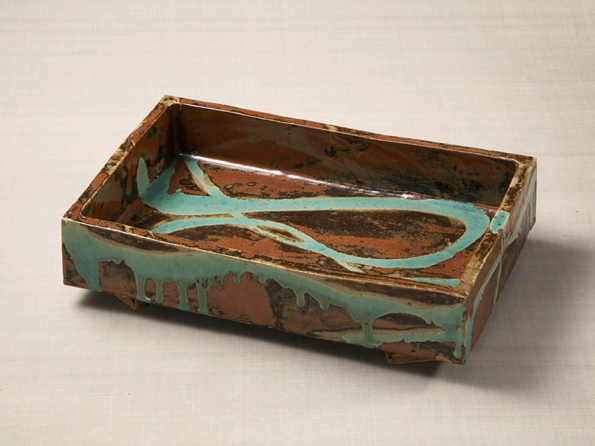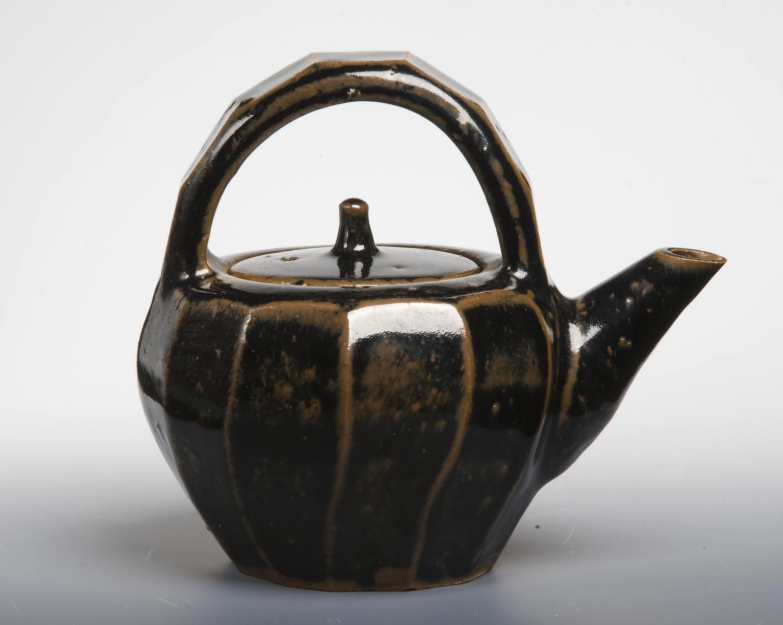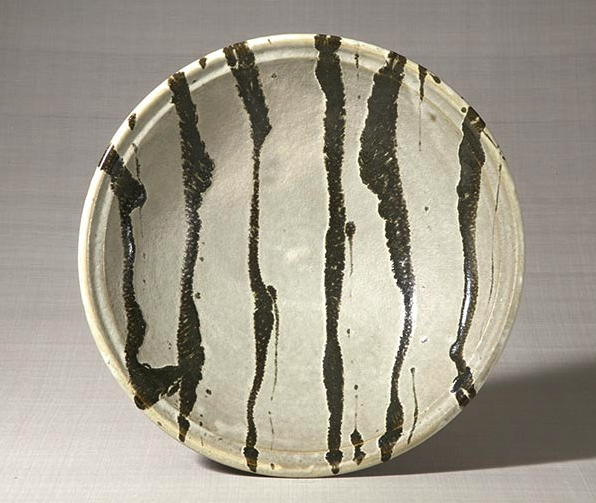Essay: Shōji Hamada and the Birth of the Studio Potter
By Alex Whittaker
Shōji Hamada outside his studio at Mashiko in 1974
Introduction
This article will address the arrival of the concept of the studio potter in relation the early 20th century ceramic production in both England and Japan. It will attempt to locate the origins of this change in the figure of the artist as a conscious and reflexive act, driven by social and political changes in Japan as it entered a period of rapid industrial and economic development, in short; modernity. By separating out the ideological goals of Mingei theory from the aesthetic experience of the artworks themselves, this text will attempt to identify the factors which brought about a new and invigorated understanding of the artistic figure at a time of unprecedented change.
The birth of the term studio potter can be traced to an exhibition by the craftsman Shōji Hamada at Paterson’s Gallery, Bond Street, London during 1923 which was then later reviewed by Charles Marriot in the broadsheet newspaper ‘The Times’ of the same year [1]. The arrival of the term also signalled the emergence of a new genre of ceramic craftsmanship as yet unseen in visual art, typified by an emphasis on the individualism of the artist. This was a figure who controlled the production of his or her own work from conception through to execution, production and finishing, resulting in ‘the birth of a new kind of autonomous artist working in clay - the studio potter.’ [2]
Fig. 1 Serizawa Keisuke, woodblock print, issued by the Nihon Mingeikan (Japan Folk Craft Museum), 1970
Origins
Yanagi Sōetsu’s Mingei theory fully emerged during the Taisho period (1912-26), following the Meiji Restoration of 1868. The restoration marked the demise of the Tokugawa shogunate which had held power over the region throughout the Edo period (1603-1867). [3] This dramatic shift in social and political policy at the end of the 19th century saw huge revisions in attitudes towards industrialisation as Japan sought to take control of its own process of modernisation amid increasing foreign influence. The rapid pace with which modernisation was achieved can be attributed to a desire initiate military, economic and social reform before it could be imposed upon Japan by the West. As Yuko Kikuchi herself noted; this was a time when ‘the government pushed along modernisation and industrialisation with the slogans; shokusan kōgyō (increase products and promote industry) and fukoku kyōhei (enrich the country and strengthen its arms).’ [4] There were, however, growing pains and although Western scientific, technological and social concepts were hastily introduced to Japan, they often arrived without context. Conversely, Japanese ‘indigenous’ ideas were regularly misunderstood thanks to the distorted lens of ‘Orientalism’ in the West. This led to many of the conditions brought about by modernity being pressed into the service of a nationalist agenda in Japan, while simultaneously ‘Japanese’, traditional cultural practices brought under the umbrella of Mingei as a means of protecting this same sense of national identity (fig. 1).
In many ways, it was the increase in commodification and mass production in Japan, combined with an open-door policy to capitalist economic trade which precipitated the Mingei movement’s ideological goals in terms of the role of the artist. In this light, Mingei can be understood as a rejection of modernity, its grand narrative of development and its end goal of globalisation. Yanagi emphasised via his criterion of beauty that objects should be made from exclusively natural materials close to the source of the materials themselves. The figure of the artist here is one who works in the spirit of ‘cooperation and self-denial’ and ‘the craftsman is expected to work in harmony with nature and not be interested in financial gain’ [5] As Brian Morean correctly noted, ‘the aesthetic ideal therefore closely parallels the social ideal.’ [6] Indeed Shōji Hamada himself stated, when asked for advice on the best way that an artist could develop their own studio practice: ‘Don’t learn what I learned, go and learn from where I learned it’ [7]
Hamada’s statement clearly highlights his attitudes towards creative development in the context of studio pottery. Rather than connecting creative development with ideas of progress through tutelage or even lineage, he advocates a return to the geographical origins of his own learning and the materials. It is also a challenge to the aspiring artist to uncover his or her own inner truth through the direct act of making. Hamada, who never signed or stamped his own ceramics, believed that his importance as the author of his works was secondary to the language inherent to the materials and formal qualities of the pots themselves, stating that ‘if you cannot see who the pot is by, it is either because the pot is bad, or because you are blind’. [8] He did, however, sign the boxes in which his ceramics were stored and transported (fig. 2), claiming that he could not ‘escape the social obligation,’ [9] suggesting that in as much as he desired his works to transcend the social and aesthetic hierarchies of capitalist labour value, he himself could not.
Labour value represented an ongoing concern for Mingei potters such as Hamada in their attempts to balance methods of production with the utilitarian ideology of the Mingei movement. Invariably this led artists to focus almost exclusively on objects that fulfilled a day-to-day function, activated by the social encounters of the people that used them. The ritualised, ceremonial ware of Chanoyu certainly provided a locus for studio potters, however it was initially considered too aestheticized to be modelled by Mingei artistic production and Hamada held off throwing these types of works. When he did finally acquiesce, he seems to have been riddled with anxiety about how to price these more exclusive pieces and genuinely haunted by the suggestion that he was capitalising on shifting his production to objects that could necessarily be sold for a higher price, saying that the ‘admonition makes my ears burn even now.’ [10]
Fig. 2 Hamada, Shōji, small box or kogo, glazed earthenware, 2.6 x 2 inches, mid 20th century.
Marston Pottery – philrogerspottery.com
Fig. 3 Hamada, Shōji Tessha, glaze cake bowl and jars, early 20th century.
This sentiment aligns with the way that artist such as Hamada and their ideological goals were narrativized from a Euro-American viewpoint at the time. In an article published in Parnassus from 1930 titled ‘The Craftsmanship of Shoji Hamada: A Japanese Master Potter’ his work was described as having ‘that moral quality which finds fullest realisation through art-craft, serving beauty in the commonest things of life’ [11] (fig. 3) After returning to Japan from a three year stay in England, where Hamada had set up the pottery in St. Ives with Bernard Leach, he fell back into what was described as an ‘unostentatious’ life, and, ‘having refused the material advantages of becoming an official instructor’ became ‘an unofficial teacher of a group of potters producing for the Japanese capital’. [12]
Studio potters such as Shōji Hamada saw the core values of the Mingei movement as resisting the onset of industrialisation and the division of labour brought about by an increase in mechanised production. Division of labour was seen as a direct threat, not only to the individual craftperson’s capacity to experience pleasure in labour, but also to the traditional practices that they considered underpinned Japanese cultural identity. They saw that the fetishized aesthetic values that Western modernity introduced had rendered the individual subservient to machines in a degrading form of dehumanised labour devoid of pleasure. Once labour became devoid of pleasure, they argued, the craftsperson became diminished, decoupled from his connection to nature itself. Yanagi said of the craftsman that;
‘He rests in the protective hand of nature; The beauty of folk-craft is the kind that comes from dependence on the Other Power (Tariki). Natural materials, natural process and an accepting heart – these are the ingredients necessary at the birth of folk-crafts’ [13]
The resistance here is twofold; ‘The protective hand of nature’ is one that also protects against the onset of increased mechanisation within folk-crafts and, by extension, a coherent cultural identity. However, Sōetsu goes further, by establishing Other Power (Tariki) as a benchmark in his criterion of beauty, he pushes Mingei theory of folk-craft into the context of religion as a self-determining activity which is explicitly one’s-own (Jiriki). Whilst Tariki here clearly identifies Sōetsu’s belief in the relationship between craft and the idealised pure lands of Amitābha Buddha, it also speaks of the importance of the individual effort that the artist must undertake in order to achieve enlightenment. Individual effort was adherence to an exterior power, but that power was explicitly not modernisation. On the contrary, it was the conservation of an already established religious system of belief. The aesthetic values of artists such as Shōji Hamada are then also a reflection of the ideological, religious underpinnings of Mingei itself - a Buddhist ideal of the non-dualistic interpretation of beauty and ugliness (fig. 4). It was this non-dual, universal idea of beauty that Sōetsu felt was best articulated through Mingei as a utilitarian, anti-intellectual concept of aesthetics and it is this same pursuit of fundamental or universal values that typifies the work of Hamada (fig. 5).
Tea Bowl with Hare’s-Fur Decoration, Muromachi Period (1392-1573), Japan, 7.3 (height) x 12.4 cm (diameter)
Hamada, Shoji, reduced stoneware tea bowl, c.1965, Japan, 8.5 (height) x 12.5 cm (diameter)
Abstractions
It is a mistake to think that the Mingei movement represented an exclusively Japanese perspective on the history of East Asian ceramics. It is equally problematic to consider Mingei in terms of an essentially national aesthetic. Mingei theory is more accurately understood as hybrid in nature, brought about by transnational interchange between global cultures at a time of intensive social and political upheaval. The onset of modernity in 1920s Japan provoked ceramic artists to create their own arts and crafts theories derived, in part, from the now faltering Arts and Crafts movement of England as its leading exponents William Morris and John Ruskin passed away at the turn of the century. [14] As we have discussed, Yanagi Sōetsu’s theory for crafts in Japan was driven by its own sense of ‘cultural ethnic nationalism’ [15] in an attempt to unite craftspeople under the banner of Mingei.
While parallels with England’s Arts and Craft movements and the attempted revival of hand crafts are clear, Yanagi consistently pressed his ideas into the servitude of national cultural identity in an attempt to align his theories with a ceramic tradition more rooted in Japan and Korea, valorising what he saw as their own ‘indigenous’ practices. Whilst it is true that Yanagi travelled to Korea in order to have his, what might now be perceived as mythological, experiences of these works first hand, Japanese artistic interchange with Korean ceramicists can be traced back centuries. The Momoyama aesthetic revival of the 1930s, for example, saw ceramicists return to the earlier restrained and utilitarian aesthetics of Karatsu-ware production which had been underway in Japan by virtue of unknown Korean craftsmen since at least the 16th century (fig. 6).
Jar, Momoyama period (1573-1615), stoneware with painted decoration in underglaze brown iron, Japan (Karatsu ware) 11.4 (height) x 15.2 (width) cm
Yanagi’s interest in Korean ceramics and the role of the utilitarian craft was shared by Bernard Leach who later adapted Yanagi’s Mingei theory. Leach himself collected his own revered example of the Moon Jar (fig. 7), which now perhaps best serves as an iconic signifier of the birth of studio potter in England. However, Hamada, Leach’s closest peer, spoke just as much of his admiration for English medieval ceramic ware, particularly jugs and chargers, (fig. 8) as he did Korean Joseon Dynasty works.
He also deeply admired Thomas Toft, a 17th century, potentially Scandinavian English potter from Staffordshire who developed his own characteristic style of heavily slip-decorated ceramic ware which espoused a similar coarseness of materiality as much earlier medieval English pottery (fig. 9). Whilst it is true to say Hamada actively sampled from Korean and Japanese aesthetic principles of simplicity and restraint, he just as readily turned his attention to European examples, blending a contemporary practice with international historical precedents in order to bring Mingei style and values into the mainstream of modern-day Japan in the early 20th century.
Moon Jar, Joseon Dynasty, Korea 18th Century, 44.5 (widest point) x 16.7 (foot) x 47 cm (height)
Fig. 9 Display Dish with Charles II, Thomas Toft, slip decorated earthen ware, ca 1680
It is this approach - a continual return to an international past in order to reinvigorate the present - that perhaps best typifies the Mingei folk-craft movement and the role of studio potters such as Hamada. Hamada spoke early on about his motivation to become a master painter rather than a potter, describing the role of the ‘artist’ as one who establishes the criterion of beauty within society. It was largely through chance encounter with the work of Bernard Leach that he started to see the possibility of interchange between the role of artist as progenitor of his or her own works and a more autonomous role as a studio potter. In Hamada, Potter by Bernard Leach, Hamada describes becoming ‘captivated by a small pitcher made by Leach’ [16] that had been part of an unchanging display for some time. Later again, Hamada encountered more of Leach’s works by virtue of an exhibition organised by the Shirakabaha group [12] (fig 10.) in response to them having received three works by Rodin as a reciprocal gift exchange on the artist’s seventieth birthday. The fact that Leach’s works were displayed in the context of a gallery alongside that of an accomplished visual artist seems to have been a pivotal moment for Hamada. That ceramic works could sit side by side with Western modern art opened up the possibility for him to purse an artform that he perceived to be more utilitarian in function. Clearly, he felt that the skillset required for sculpture was entirely interchangeable with those of the studio potter and that, aside from functionality, he drew very little distinction between the two.
Shirakaba, first issue cover, April, 1910
Outcomes
Early 20th century Mingei ceramic artists such as Shōji Hamada promoted the idea that value lay in the un-rarefied production of everyday goods made by craftspeople, rather than in refined technique or an intellectual process of aesthetic development. For him, the role of the studio potter was even perhaps best practiced among the uneducated or illiterate rather than the aesthetic elites. Among ‘folk’ was as a place where Yanagi Sōetsu had already felt there was a distinct lack of ugliness, rather he saw a pervasive and humble faith in the value of everyday things. The birth of the studio potter, represents a return to these long held ceramic traditions which can now be best understood in the context of transnational artistic exchange, rather than either as a cultural trope or inherently national style. The arrival studio potter marks a reinvention of the role of the ceramic artist as a figure at once de-emphasised in terms of artistic authorship, yet empowered with a new sense of individualism and ownership over the practice of his or her craft.
Shōji Hamada was fully recognised in 1955 as the first person – a studio potter - to become designated as a ‘National Living Treasure’ and considered a ‘Preserver of Intangible Cultural Property’ by the Japanese government.




Notes
[1] Stair, Julian – The Spark that Ignited the Flame, Hamada Shōji, Paterson’s Gallery and the birth of English Studio Pottery p109
[2] Ibid.
[3] Encyclopedia Britannica – online https://www.britannica.com/event/Meiji-Restoration accessed 2/07/2023
[4] Kikuchi, Yuko – Japanese Modernisation and Mingei Theory, RoutledgeCurzon, 2004, p77
[5] Moeran, Brian - Japanese Social Organization and the Mingei Movement, Pacific Affairs, Spring 1981, p43
[6] Ibid.
[7] Bernard Leach – Hamada Potter, Thames and Hudson 1976, p20
[8] Ibid p93
[9] Ibid.
[10] Hamada, Shoji – On Making Tea Bowls, translated by Victoria Oyama, Ceramics Technical, No. 26, 2008, p34
[11] Finch, Arthur Theodore – The Craftsmanship of Shoji Hamada, A Master Japanese Potter, Parnassus, April, 1930, Vol. 2, No. 4, p32
[12] Ibid
[13] Yanagi, Soetsu & Leach, Bernard – The Unknown Craftsman, Kodansha, 2013 p200
[14] Ibid p112
[15] Kikuchi, Yuko– A Japanese William Morris, Yanagi Soetsu and Mingei Theory - https://morrissociety.org/wp-content/uploads/SP97.12.2.Kikuchi.pdf accessed 12/07/2023
[16] Bernard Leach – Hamada Potter, Thames and Hudson 1976, p20
[17] The Shirakaba-ha Group, which translates at ‘The White Birch Society’ were an instrumental group that also published an influential and widely dispersed journal of the time - Shirakaba














